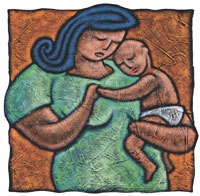WHO
Updates Treatment Guidelines for Pregnant Women and Infants
Using Single-dose Nevirapine
 |
 |
 |
 |
| SUMMARY:
The World Health Organization
(WHO) this week updated its antiretroviral therapy
(ART) guidelines for women and infants who received
single-dose nevirapine
(Viramune) to prevent mother-to-child HIV transmission
during delivery. The revision is based on 2 studies,
published in the October 14, 2010 New England
Journal of Medicine, showing that even a single
dose of nevirapine was associated with drug resistance
and subsequent treatment failure. Therefore, WHO
recommends, women exposed to single-dose nevirapine
within the past year should be treated with a combination
regimen containing drugs other than NNRTIs, and
babies should receive lopinavir/ritonavir
(Kaletra). |
|
 |
 |
 |
 |
By
Liz Highleyman
 Single-dose
nevirapine is commonly used for prevention of mother-to-child
transmission in resource-limited settings, especially for
women who do not receive care until the time of delivery.
But prior studies have shown that women and infants exposed
to a single dose often develop drug resistance, which can
compromise the effective not only of nevirapine itself, but
also other non-nucleoside reverse transcriptase inhibitors
(NNRTIs).
Single-dose
nevirapine is commonly used for prevention of mother-to-child
transmission in resource-limited settings, especially for
women who do not receive care until the time of delivery.
But prior studies have shown that women and infants exposed
to a single dose often develop drug resistance, which can
compromise the effective not only of nevirapine itself, but
also other non-nucleoside reverse transcriptase inhibitors
(NNRTIs).
The first
study, known as OCTANE A5208, looked at 745 women in 7
African countries who required ART for their own health; 241
of them had previously received single-dose prophylactic nevirapine
during delivery.
Women
treated with a nevirapine-based ART combination regimen were
significantly more likely to experience virological failure
or death than those using a lopinavir/ritonavir-based regimen,
both also containing tenofovir/emtricitabine
(Truvada) (26% vs 8%, respectively; P = 0.001).
Nevirapine
resistance was detected in 14% of previously exposed women.
Looking just at this subgroup, 73% of those who subsequently
received the nevirapine combination regimen experienced virological
failure or death, compared with 6% of those using the lopinavir/ritonavir
regimen.
In an analysis of 500 women who had never received prophylactic
single-dose nevirapine, rates of treatment failure or death
were the same in the nevirapine and lopinavir/ritonavir combination
therapy arms (both 14%).
Nevirapine resistance, and the associated risk of treatment
failure, diminishes over time, however, and the guidelines
advise that women can safely use the drug again if at least
12 months have passed since they received the single prophylactic
dose.
In the second
study, Paul Palumbo and colleagues with the P1060 study
team looked at treatment outcomes among 164 infants (age 6-36
months) in 6 African countries who were exposed to single-dose
nevirapine during delivery or immediately after birth.
Researchers found that babies subsequently treated with a
nevirapine-based combination regimen were significantly more
likely than those receiving lopinavir/ritonavir (both in combination
with zidovudine/lamivudine, or Combivir) to experience virological
failure or discontinue treatment at 24 weeks (40% vs 22%,
respectively; P = 0.02).
Baseline nevirapine resistance was detected in 12% of the
infants, and it predicted treatment failure. Among babies
with resistance mutations, 83% of those taking the nevirapine-based
regimen experienced virological failure or stopped therapy,
compared with 18% of those on the lopinavir/ritonavir-based
regimen.
"Since
nevirapine is used for both treatment and perinatal prevention
of HIV infection in resource-limited settings, alternative
strategies for the prevention of HIV transmission from mother
to child, as well as for the treatment of HIV infection, are
urgently required," the study authors concluded.
But
this presents a challenge, Marc Lallemant and Gonzague Jourdain
from Harvard School of Public Health acknowledged in an accompanying
editorial, because nevirapine is among the cheapest and most
widely available antiretroviral drugs in low-income countries.
"The
results of the OCTANE and P1060 trials are highly relevant
despite the paradigm shift away from interventions incorporating
single-dose nevirapine to interventions comprising highly
active antiretroviral drugs for the prevention of mother-to-child
transmission," they wrote. "In resource-limited
settings, where many women still present late for antenatal
care and too few are screened for CD4+ cell count, single-dose
nevirapine will most likely remain an important component
of the toolkit for the prevention of mother-to-child transmission."
The
WHO treatment guidelines are available online:
10/19/10
References
P
Palumbo, JC Lindsey, MD Hugher, A Violari, and others. Antiretroviral
treatment for children with peripartum nevirapine exposure.
New England Journal of Medicine 363(16): 1510-1520
(Abstract).
October 14, 2010.
S
Lockman, MD Hughes, J McIntyre, JS Currier, and others. Antiretroviral
therapies in women after single-dose nevirapine exposure.
New England Journal of Medicine 363(16): 1499-1509
(Abstract).
October 14, 2010.
M
Lallemant and G Jourdain Preventing mother-to-child transmission
of HIV -- protecting this generation and the next (Editorial).
New England Journal of Medicine 363(16): 1570-1572.
October 14, 2010.
Other
Source
National
Institute of Allergy and Infectious Diseases. NIH Studies
Influence Revision of WHO Guidelines for Treating HIV-Infected
Women, Infants. NIH News press release. October 13, 2010.
